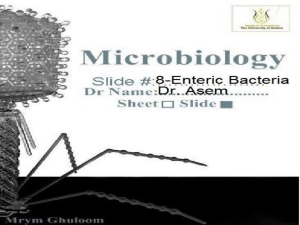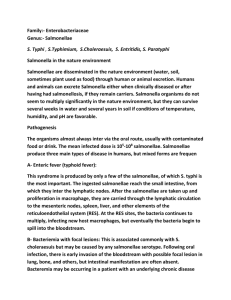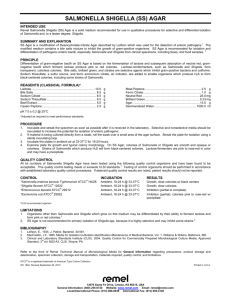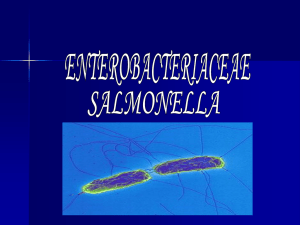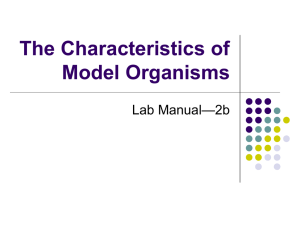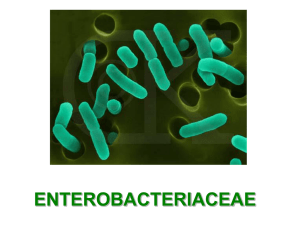PPT
advertisement
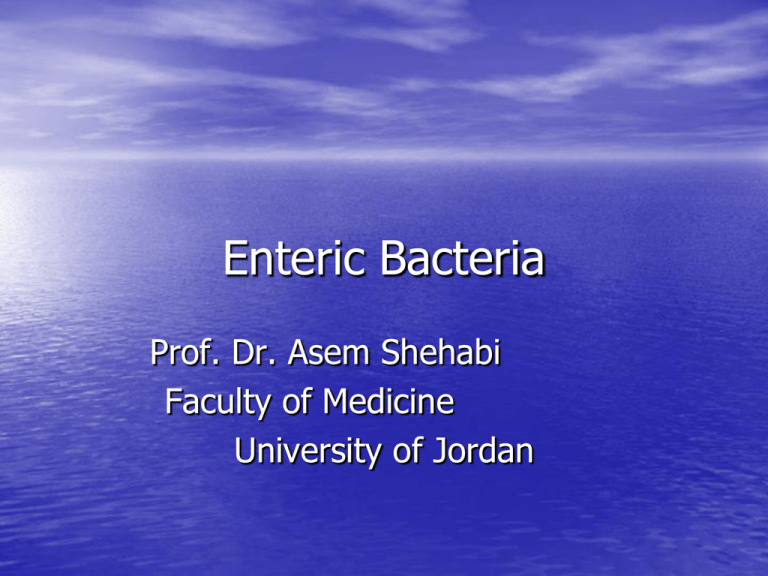
Enteric Bacteria Prof. Dr. Asem Shehabi Faculty of Medicine University of Jordan Enteric Bacteria • General Characteristics: Gram-ve Bacilli, Facultative Anaerobes, Intestinal Normal Flora.. Humans, Animals, Birds.. Common Waste water, Natural Water, Soil, Vegetation. • Opportunistic Pathogens/Obligate Pathogens.. Enterotoxins, Endotoxins, Capsule, Flagella. • Coliform Group: 1. Escherichia coli: Urinary Tract Infect (40-70%)..Single Organism, Septicemia, Meningitis, Wounds. Diarrheagenic E coli Strains: Enteropathogenic (Infants), Enterotoxigenic ( Heat-Labile/Stable Enterotoxin).. Watery diarrhea Children/Adults.. Travelers.. Contamination Water/Vegetables / Fresh Food ..Self-limited E. coli Culture – Red color on MacConkey agar indicates Lactose positive & Gram-stain Coli-form Bacteria 2. Klebsiella-Enterobacter species: UTI, Septicemia, Wounds.. Rare Meningitis.. Common Hospitalized patients. K. pneumoniae.. Nosocomial infections..Pneumonia 3. Proteus-Providencia species: UTI, Septicemia, Wounds.. Common Hospitalized patients. 4. Pseudomonas aeruginosa & Pseudomonas group. Several Enzymes & Toxins.. Common Water Environment, Vegetations, Disinfection Solutions, Wounds, Burn.. Blue Green Pus, External Otitis Media, Septicemia, Pneumonia, UTI, Nosocomial Infect, Mutlidrug Resistance.. Diagnosis: MacCokeny -Blood Agar.. CLED, Biochemical Tests. E.coli-Flagella-Fimbriae-Pili Klebsiella pneumonia-Capsule Salmonella group • • • Gram-ve bacilli.. Facultative Anaerobes.. Lactosenegative, Endotoxin/LPS.. common in Nature.. Humans, Animals, Birds.. O/H- Antigens..Specific antibodies Salmonellosis: 1-Gastroenteritis /Food-poisoning Salmonella: S. enterica/ enteritidis.. 2000 Serotypes.. Common Birds, Farm Chickens, Pets.. Contamination.. Food-poisoning.. Chicken MeatEggs, Water.. Fecal-Oral Infection.. Incub. 8-24 h.. Mild-Severe Diarrhea, Vomiting, Fever.. SelfLimiting.. Adults Rarely Septicemia-Meningitis Infant/young Children.. Immun-difficiant Patients V. cholerae – Salmonella/ Flagella Hekton–Enteric agar for Isolation of Salmonella (E.coli-Salmonella growth) Typhoidal Salmonella • Lab Diagnosis: Culture Feces, Food.. S-S Agar, Hekton-enteric agar. Prevention.. Control Sanitation & hygiene.. 2- Typhoidal Salmonella: Human Enteric Fever.. Salmonella enterica /typhi & paratyhi A, B, C.. Invasive, only human,FecalOral, Human Healthy Carriers.. Water-Food.. Incub. 1-3 Weeks.. high Fever, Diarrhea, Septicemia, Meningitis, hepatospenomegaly, Intestinal Perforation.. Healthy Carriers.. Gallbladder.. Intestine.. Short/Life Long • Lab Diagnosis: Culture Feces, blood, Urine, CSF, Selective Media.. Serological Widel Test for detection of specific antibodies against O & H antigens ( Titer > 160) Antibiotic, Human vaccine available. Shigella group • 4- Shigella species.. Endo/Enterotoxins.. Lactose- • • negative, Susceptible to Dryness, Acid, Low-High Tempt. Fecal-Oral infection.. Water, fresh Vegetations, Few serotypes.. Incub. 1-2 Days.. Common S. Sonnei, Sh.boydii .. Purulent-Bloody-Diarrhea..not invasive S.dysenteriae.. Enterotoxin /Neurocytotoxin...., Necrosis, Fever, Severe Purulent-Bloody-Diarrhea Abdominal Cramps, CNS.. Rare Septicemia. Lab Diagnosis: Feces Culture.. S-S Agar, Hecton – Enteric Agar.. Recommended Antimicrobials Treatment .. Control Sanitation & hygiene. Vibrio cholerae • Gram-ve Vibrios.. Aerobic Growth.. Alkaline Medium • • • (pH >8-9).. Water.. Fresh Food..Reservoir human & water. Endemic In India/Bangladish.. Epidemic Disease, Causeing human Outbreaks. V. cholerae-01: Type V. cholerae El-Tor.. Only Human.. Fecal-Oral Infection.. Raw Sea/ Fresh Foods, Small Intestine Infect. Cholera-enterotoxin, Incub. 848 h.. Severe Water Diarrhea-Dehydration.. Shock.. Death.. Lab Diagnosis: Feces Culture.. Selective TCBS agar. Treatment: Replacement Fluids & Electrolytes.. Antibiotic.. Public Heath Measurements.. Human Vaccine. Cholera TCBS agar for isolation of V.cholerae/ Salmonella–Shigella agar (Lactose-negative) Brucella species • Brucellosis/Malta Fever.. Gram-ve coccobacilli.. Intracellular, Endotoxins.. Primarily pathogens of Animals (causing Zoonosis), Localized Infection in animal reproductive Organs,Sepsis, Abortions. • Br. abortus (Cattel), Br. melitensis (Goats/Sheep). • Human Brucellosis/Malt Fever : Mostly Br. melitensis.. Rare Other species in Jordan. • Transmitted to Humans:Unpasteurized Milk/Milk Products.. Cheese, Direct Animal Contact.. Few Cells Enter Through GI, Skin Abrasions, Eye, Inhalation/Droplets.. Intracellular ..Lymphatic System.. Septicemia, Meningitis, Chronic disease..long life Brucella-2 • Clinical Features: Incub. 1-6 Weeks.. Intermittent • fever, headaches, fatigue, joint and bone pain, GI Symptoms, Sweats, Back Pains, Acute- SubacuteChronic Infections. Common Complications.. Arthritis, Meningitis-CNS, Osteomylitis, Localized Lesions in any body part. • Lab Diagnosis: Culture Blood, CSF, Bone marrow (Chronic • • Infection).. Brucella agglutination Test.. Specific Antibodies Treatment: 6-8 Weeks with Antimicrobial drugs Prevention: Control Brucella in Animals by slaughtering infected animals, Vaccination, Pasteurization Milk/ Milk Products Campylobacter Species • C. jejuni is Gram-negative slender, curved, motile • • • • • rod, Grow Microaerophilic.. Optimal growth 42 C. This bacterium became important enteric pathogen since 1976..widely spread in small animals.. Birds It is primarily an animal pathogen causing abortion and enteritis in sheep and cattle. C. jejuni infection causes mild-moderate diarrhea, Children.. watery or sticky, contain blood , fecal leukocytes Other symptoms often present are fever, abdominal pain, nausea, headache and muscle pain. The illness usually occurs 2-5 days after ingestion of the contaminated Chicken Meat, Milk, food water. Diagnosis: Stool culture .. Selective Capylobacter Media including 3 antibiotics. Helicobacter Species • Helicobacter pylori is a spiral shaped bacterium that lives in the mucus lining Pyloric interim-stomach • • • and duodenum..Cytotoxin, Only pathogenic in human The stomach is protected from its own gastric juice by a thick layer of mucus that covers the stomach lining. The bacteria are found worldwide, where up to 10% of children - 80% of adults can have evidence of an H. pylori infection - usually without having any clinical signs or symptoms. Transmission route.. Close personal contact, less other sources. Helicobacter Helicobacter Species-2 • Common symptoms: gastritis or peptic ulcer • • • /Stomach.. duodenal ulcers disease.. burning Abdomen, Pain,Nausea,Vomiting. Persistence of ulcers .. development of Stomach Cancer and Lymphoma. H. pylori can be successfully eradicated (95%) using a combination of certain antibiotics and medicines that suppress stomach acid production. Common Reoccurrence within few weeks-months. Diagnosis: Urea BreathTest, Culture Stomach Biopsy.. Selective Medium.. 42C, Specific H. pylori antibodies not significant alone.
